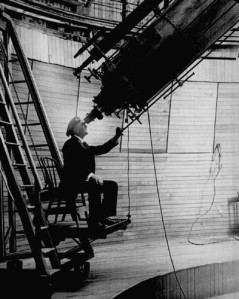Victorian Venus Spokes June 9, 2010
Author: Beach Combing | in : Modern , trackback
Beachcombing has had a gratifying amount of correspondence over his recent article on Martian Vegetation. He thought then that he would call into cause another planet, Venus and the great Percival Lowell (1855-1916) who wrote on both planets in works including Mars and Its Canals (1906) and Mars As the Abode of Life (1908). (The sentimentalist in Beachcombing thanks the stars that Lowell did not live long enough to see his dream of Martian civilisation destroyed by spiteful NASA probes.) Lowell also indulged himself in the orient with works such as Esoteric Shinto and Occult Japan, but Beachcombing will leave those for another time…
Lowell first properly spent time on Venus in the summer and autumn of 1896, noting that the morning star had a strange spot at its centre with spindly spokes coming out of it. Lowell and Lowell alone saw this strange pattern on Venus’ surface: it was never noted in any later descriptions of the planet and even Lowell’s assistants, to judge from their illustrations, were looking at something rather different.
Lowell was predictably (and as it happens correctly) criticised for his findings. In 1902 he even partially backed down speaking of an optical problem. But he afterwards quickly reverted to type – confident, intolerant, very occasionally obnoxious – and shrugged off the bantering of his enemies. Indeed, on observing Venus again in 1903 he saw the phenomenon ‘with a definiteness to convince the beholder of an objectiveness beyond the possibility of an illusion.’ He even went so far as to speculate about a ‘funnel-like rise of hot stagnant air, creating a partial vacuum… filled by draughts of cold air from the night side coming in from all sides of the periphery, thus giving rise to a spoke system’. That’s the spirit Percy!
But how was it that this only Lowell saw the spokes? The problem was finally resolved in 2003 in an article by William Sheehan and Thomas Dobbins – ‘The Spokes of Venus: An Illusion Explained’, Journal of the History of Astronomy 34 (2003) pp. 53-63. It transpires that Lowell, to see Venus, had aggressively stopped down his telescope. In doing so he had accidentally turned it into an ophthalmoscope, an instrument used for examining eyes in microscopic detail. In other words, what Lowell was observing on the surface of Venus was his own retina. The spindly spokes were blood vessels!
Beachcombing can’t help thinking there is a lesson for us all here. Certainly, it is striking how so many in the humanities have historical positions that bear an uncanny resemblance to their personalities – like the old saw about owners and pets. Why else would all of Beachcombing’s most dearly held hobbyhorses be ones that ride heavily over the toes of everyone sitting before him in the lecture hall?
Any other curious records concerning Venus – Mars always is given unfair attention – would be most gratefully received. [drbeachcombing[AT]yahoo[DOT]com].
14 Aug 2014: Stewart writes ‘Your post on “Venusian Spokes” was interesting and it was nice to see that the whole thing was neatly tied up with the revelation that Lowell’s telescope was also functioning as an opthalmoscope. However, there is another case of odd features on Venus that has a far different resolution. In the eighteenth and nineteenth centuries (“18 cent” and “19 cent” as you call them), a small handful of astronomers reported seeing some very low-contrast smudgy features on Venus. Other astronomers with instruments of the same or even greater quality never saw them. Yet, these features were not hallucinations nor were they telescopic effects. When Mariner 10 flew past Venus, it used cameras that could see in the ultraviolet. These images revealed dark features that were only visible in the ultraviolet. It seems that the few astronomers who reported those features apparently had some visual sensitivity in the ultraviolet. The Mariner 10 discovery solved one mystery, but raised another. To this day, nobody is certain what substance causes the ultraviolet-dark clouds to appear as they do. Based on studies of the spectrum of these features, it appears that the ultraviolet absorbing substance is some kind of compound of carbon and sulfur. Some have even speculated that it is carbonyl sulfate. But the problem with that is the only way we know of forming carbonyl sulfate is through biology. That would be out of the question on Venus. Perhaps the mystery compound is something that is formed by some odd chemical interaction with the carbon dioxide and sulfuric acid in the Venusian atmosphere. I suspect it will be quite some time before this is figured out.’ Thanks Stewart!



